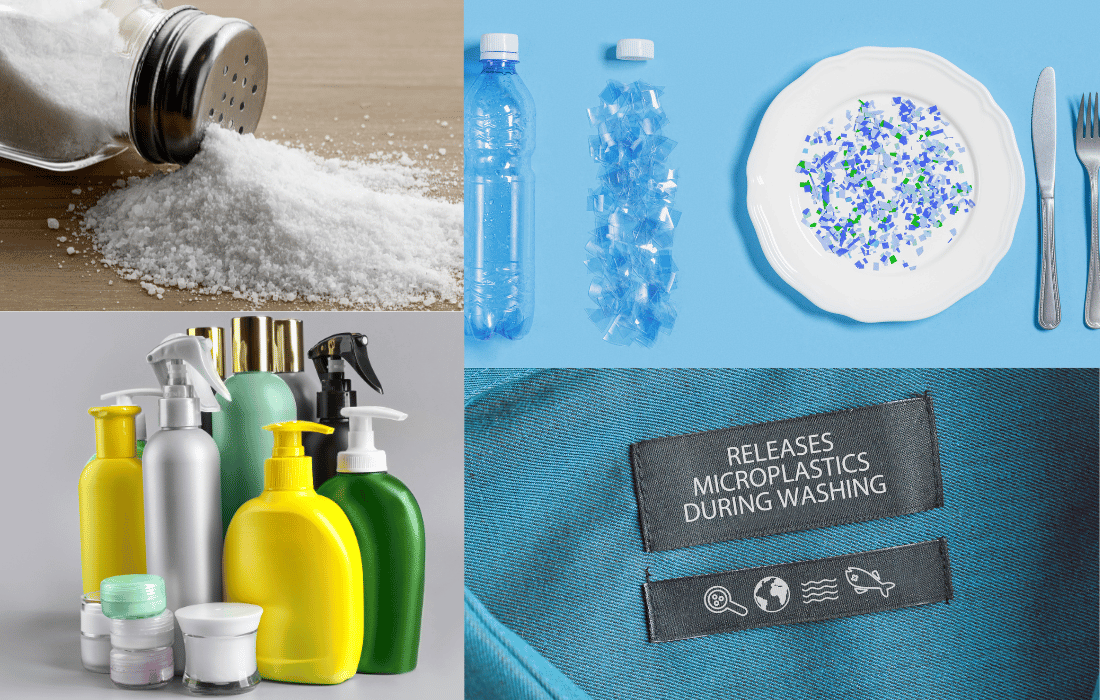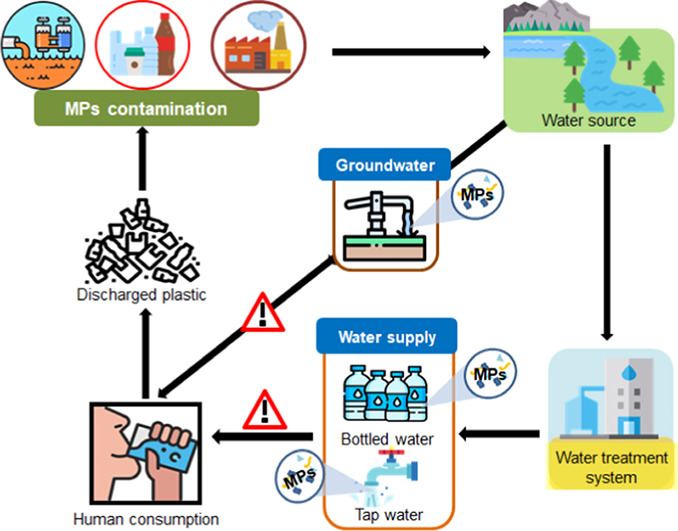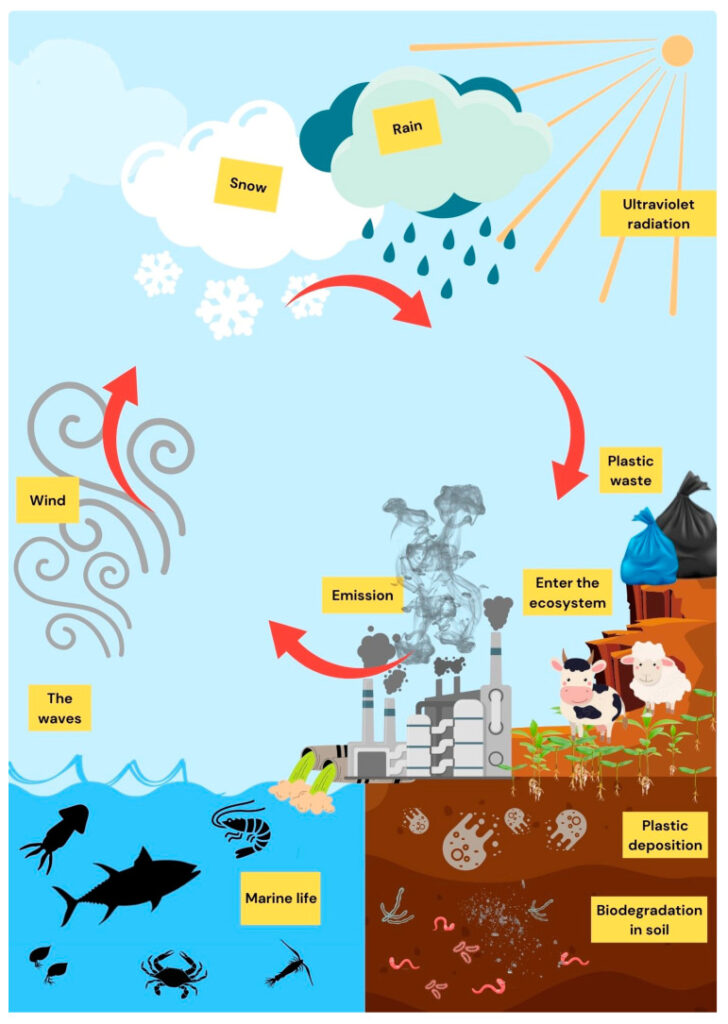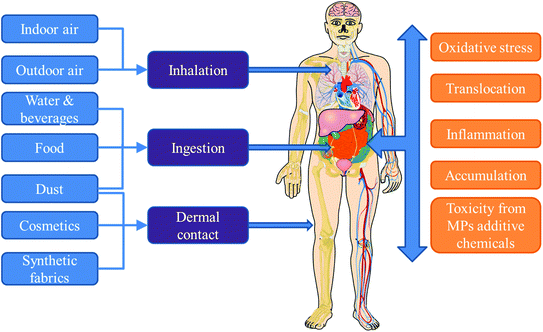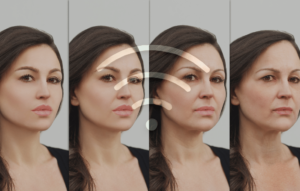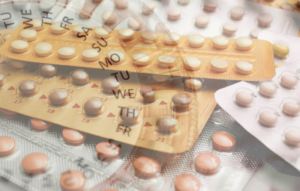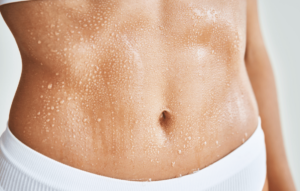Microplastics are everywhere. From the air we breathe to the water we drink and the food we eat, tiny plastic particles have infiltrated almost every part of our lives. Once thought of as inert, recent research has shown these microplastics not only persist in the environment but are now being linked to serious health consequences like endocrine disruption, inflammation, and even obesity. What was once simply a pollution problem for our oceans is now an unavoidable part of daily life.
A 2021 study noted that humans ingest tens of thousands to millions of microplastic particles annually. These particles can come from inhaling indoor air, drinking bottled water, and even everyday items like clothing or food packaging. Even more concerning, smaller particles (less than 20 microns) can penetrate biological membranes and potentially disrupt bodily functions on a cellular level. These findings, paired with other studies, illustrate how pervasive and dangerous microplastic exposure has become.
But before we succumb to despair, there are ways we can reduce our microplastic exposure. Making conscious lifestyle adjustments can significantly cut down on the toxins we’re ingesting and breathing in. In this article, I’ll break down the top sources of microplastic exposure and provide holistic solutions you can integrate into your life to help minimize these risks.
1. Personal Care Products: The Microbeads in Your Bathroom
Personal care products like facial scrubs, body washes, and even toothpaste are significant contributors to microplastic pollution. Many of these products contain plastic microbeads, tiny synthetic particles designed to exfoliate or add texture. These beads, typically made from polyethylene (PE), are small enough to pass through water filtration systems, entering oceans and rivers, where they contribute to the massive accumulation of microplastics in the environment.
A 2015 study estimated that about 8 trillion microbeads were entering aquatic ecosystems daily in the U.S. alone, causing harm to marine life that mistakenly ingests them, thinking they are food. Furthermore, these particles can act as carriers for other toxic chemicals found in the environment, making them doubly dangerous for both marine organisms and humans who consume seafood.
A growing body of evidence suggests that microbeads also pose risks to human health. Once in water systems, they can absorb toxins such as phthalates and bisphenols. When marine life ingests these particles, the contaminants can work their way up the food chain to humans. Phthalates and bisphenols are endocrine disruptors, linked to hormone imbalances, reproductive issues, and even increased cancer risk.
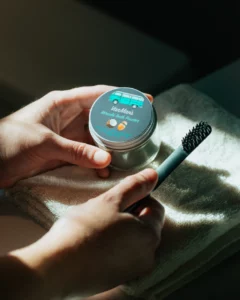
Holistic Solution
Switching to natural personal care products is a simple yet effective way to cut down your microplastic exposure. I recommend VanMan for high-quality, toxin-free skincare that eliminates harmful plastics and nourishes your skin using holistic, natural ingredients. Beyond that, their commitment to sustainability ensures that you’re not just protecting your body but also contributing to the larger movement of reducing plastic pollution.
2. Drinking Water: Bottled Water’s Hidden Microplastics
Bottled water has become one of the most notorious sources of microplastic contamination. A comprehensive study found that bottled water contains an average of 325 plastic particles per liter. Given that many people consume bottled water thinking it’s safer than tap, these findings are particularly alarming. Tap water, while not entirely free of microplastics, tends to have much lower concentrations, depending on the treatment process.
Unfortunately, it’s not just bottled water we need to worry about. Municipal water supplies also show signs of microplastic contamination, especially in areas with older plumbing systems. Plastic pipes can break down and leach microplastics into the water, adding yet another layer to the contamination.
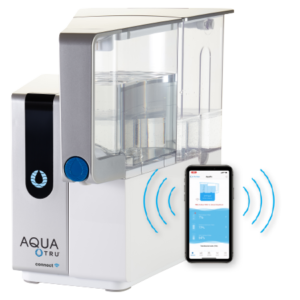 Holistic Solution
Holistic Solution
Filtering your water is the best way to reduce exposure. I highly recommend the AquaTru Countertop Reverse Osmosis System. This system uses reverse osmosis technology to remove up to 99% of microplastics, as well as other harmful substances like chlorine, fluoride, and heavy metals. With a high level of filtration, it ensures you’re drinking the cleanest water possible. Not only does it protect your health, but it also reduces your reliance on plastic bottles, further cutting down on microplastic waste.
Also, try to avoid ordering water from restaurants. Bring your own, or make sure you’re hydrated beforehand. They may use filtered water instead of tap water, but filtered water is not the same as purified. Avoid plastic bottles too.
3. Seafood: Microplastic Contamination in the Oceans
Our oceans are filled with discarded plastics that break down into smaller particles over time. Marine life, including fish, shellfish, and even seaweed, consume these particles, meaning we’re indirectly consuming them when we eat seafood. A 2019 study found that the average seafood lover could ingest up to 11,000 microplastic particles annually from their diet alone.
What’s particularly worrying is the potential health effects of this microplastic exposure. Studies have shown that consuming microplastics can lead to endocrine disruption, oxidative stress, and even metabolic disorders. Given that fish and shellfish are staple proteins for many, it’s a source of contamination that can’t be ignored.
Holistic Solution
While it’s almost impossible to completely avoid microplastics in seafood, you can opt for wild-caught Alaskan fish whenever you get your fish craving. Wild-caught fish are generally considered to have lower concentrations of microplastics compared to their farm-raised counterparts. Alaskan fish, in particular, come from cleaner waters, offering a better nutritional profile with fewer environmental contaminants. If you’re looking to ensure high-quality, low-microplastic seafood, check out Wild Alaskan Company for top-tier options.
4. Airborne Microplastics: Invisible Pollutants in the Air We Breathe
Microplastics don’t just come from the ocean or the products we use—they’re also in the air. Studies show that indoor air contains significantly higher levels of microplastics than outdoor air. This is largely due to synthetic fibers shedding from carpets, clothing, and upholstery. Every time you sit on your couch or vacuum your floor, microfibers are released into the air, which is then inhaled.
Once inhaled, microplastics can lodge in the respiratory system, leading to inflammation and potentially contributing to chronic respiratory conditions. With indoor air quality already a concern for many people, adding microplastic exposure to the mix only increases the urgency to address this issue.
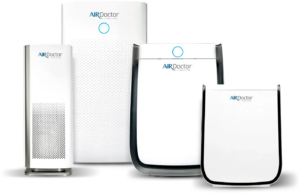 Holistic Solution
Holistic Solution
To reduce the number of airborne microplastics in your home, consider investing in a high-efficiency air purifier like the AirDoctor. This purifier captures airborne particles, including microplastics, helping to ensure that the air you’re breathing is as clean as possible. Along with this, consider reducing synthetic materials in your home and opting for natural fibers wherever possible.
5. Packaged Foods: Plastic Contaminants in What We Eat
Packaged foods are often stored in plastic containers, which can leach microplastics and harmful chemicals like phthalates and bisphenols into the food. This contamination can occur during processing, storage, and even while food is sitting on your kitchen counter. Single-use plastics, cling wraps, and plastic food storage containers all contribute to microplastic ingestion.
What’s even more concerning is the cumulative effect of these exposures. Over time, small amounts of plastic ingestion can build up in the body, leading to long-term health consequences, including disrupted metabolism, endocrine dysfunction, and possibly an increased risk of cancer.
Holistic Solution
The simplest way to reduce your exposure is to Just Eat Real Food. Prioritize whole, unprocessed foods that haven’t been packaged in plastic. When shopping, ditch the plastic produce bags and bring your own organic cotton produce bags. These reusable bags are not only more sustainable, but they also eliminate the need for single-use plastics at the grocery store. You can even go one step further and use glass containers to store your food at home, further reducing your plastic footprint.
6. Table Salt: Debated Necessity
Salt is one of the most debated items when it comes to microplastic contamination. A 2019 study found that over 90% of the salt brands tested contained microplastics. Given that salt is something we use almost daily, this is concerning news for anyone trying to minimize exposure.
However, not all salts are created equal, and much debate surrounds which brands are safest. Personally, I’ve been enjoying Baja Gold as the chosen sea salt of my home, but recommend you to do your own research on which salt is best for you.
Holistic Solution
For now, I suggest keeping an eye on the evolving research. As with any food product, it’s important to choose quality brands and stay informed about potential contaminants. In the meantime, consider diversifying your salt sources and limiting your intake of highly processed salts that are more likely to contain microplastics.
7. Synthetic Clothing: The Microfiber Shedding Epidemic
Synthetic clothing, made from materials like polyester, acrylic, and nylon, is one of the largest sources of microfiber pollution. Each time you wash your clothes, millions of microplastic fibers are released into the water, making their way into oceans and drinking water supplies. What’s worse, these fibers are not effectively filtered out by water treatment facilities, meaning they persist in the environment and end up in our food chain.
A 2016 study found that a single load of laundry could release up to 700,000 microplastic fibers into the water. Over time, these fibers accumulate in the environment and eventually find their way back into our bodies through food and water consumption.
Holistic Solution
To reduce your contribution to microfiber pollution, switch to clothing made from natural fibers like organic cotton, organic wool, or alpaca fur.
8. Holistic Lifestyle Changes: Creating a Microplastic-Free Future
While we may not be able to eliminate microplastic exposure entirely, we can take significant steps to reduce our intake and limit the toxic burden on our bodies. Here are some key lifestyle changes you can implement to minimize your risk:
- Switch to Natural Skincare Products: Personal care items like those from VanMan eliminate harmful microplastics and nourish your skin with organic, natural ingredients.
- Filter Your Water: Invest in a quality reverse osmosis system like the AquaTru Countertop Reverse Osmosis System to ensure you’re drinking water free from microplastics, fluoride, and other contaminants.
- Choose Sustainable Seafood: Opt for wild-caught Alaskan fish when eating seafood to avoid consuming microplastic-laden farmed fish.
- Invest in an Air Purifier: Use the AirDoctor to clean the air in your home, filtering out airborne microplastics and other harmful pollutants.
- Buy Whole Foods: Follow the Just Eat Real Food (JERF) philosophy and avoid heavily packaged or processed foods that are stored in plastic.
- Upgrade Your Wardrobe: Wear clothing made from organic cotton, wool, or alpaca fur to reduce your exposure to synthetic microfibers and embrace sustainable fashion.
Conclusion: Microplastic Awareness is the First Step
The evidence is clear: microplastics are a pervasive problem that impacts every part of our lives. From the water we drink to the air we breathe, these tiny particles have found their way into our bodies, disrupting our health in ways we are only beginning to understand. However, by making conscious choices about the products we use, the foods we eat, and the water we drink, we can significantly reduce our exposure and protect ourselves from the toxic effects of microplastics.
Reducing microplastic exposure is not just about detoxing—it’s about taking a stand against environmental pollution and supporting a more sustainable, holistic way of living. Every small shift in our habits adds up to a healthier, more balanced life for ourselves and future generations.
Stay tuned for updates as I continue my research, and in the meantime, remember: the power to create a cleaner, healthier world starts with you.

